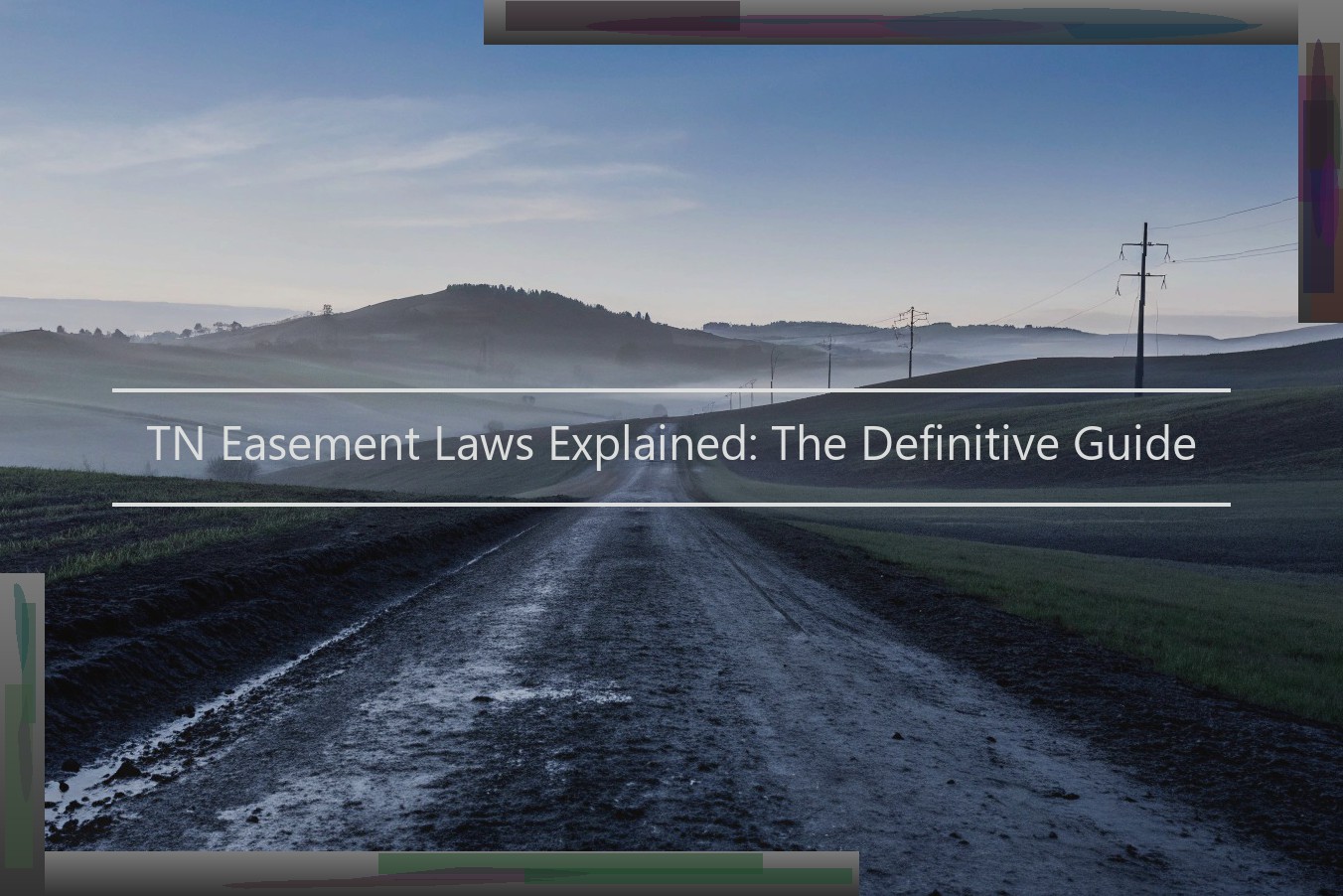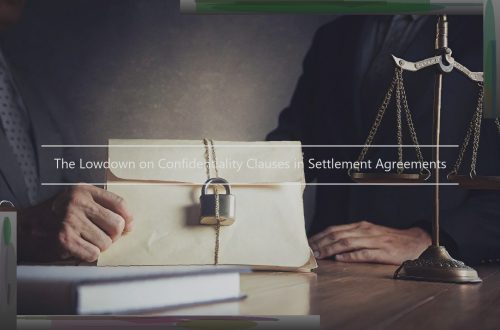TN Easement Laws Explained: The Definitive Guide
What Is an Easement?
The words and phrases lawyers use to discuss property rights can be confusing at times. Understanding how easements in property ownership work is important in any real estate transaction. An easement is the right of one person to use somebody else’s land. There doesn’t have to be a connecting road or path for there to be an easement. The rights granted in an easement are specific and limited to just what is stated in the legal description of the easement.
Easements can be used for many purposes. For example , an easement can provide access from a road to the rear of a development. It may provide a utility company the right to run water supply lines across your property – as in a water main or a sewer line. It can give the oil and gas industry the right to drill on your property without it being integrated into the possessory interests of its new home. An easement for ingress and egress is more specific; it allows a person to go on and off your land at will in a particular location. Think of these like a driveway. Instead of a physical driveway, a grant of rights to use someone else’s road or path serves the same purpose: it allows you to go on and off a piece of property without having been integrated into the land.
Easements can be created in many ways. They can be created by deed, prescription, necessity, implication or reservation. It is important for the respective landowners to understand what is actually being conveyed by the easement, as well as all the limitations.

Types of Easements in TN
Tennessee law recognizes three primary types of easements: express easements, implied easements and prescriptive easements.
An (1) express easement is defined as "a right … in the land of another, which is created or reserved by express grant or reservation from the owner of the servient tenement." Roberts v. LZRV, Inc., 124 SW3d 446 (Tenn. Ct. App. 2003); see also 14 Tenn. Jur. Easements and Way 2 (1974). In other words, easements created by will, deed and reservation are express easements. An example of an express easement is when a right-of-way is created by a deed. In the deed, the grantor of the easement may describe the location with particularity, and even state that the easement is for a specific purpose. Express easements are enforceable upon the death of the grantor.
An (2) implied easement is one where the owner of a tract of land conveys a portion of it to another with the expectation that an easement over the donor’s adjacent land will accompany the transaction. See 25 Am. Jur. 2d Easements and Licenses in Real Property § 4 (1999).
There are two types of implied easements that arise by acts and necessity. Generally, an implied easement of acts arises when only one tract of land is owned and a way of access exists across that land. For example, if you have landlocked property (property that has no access except through your property) and you own both properties, the burdened property owner has the right to use that access. However, this does not include the right to use the property beyond the access point. Additionally, if the property owner sells the burdened property without expressly granting the access, the right of access passes with ownership of the property. In other words, the access point cannot be severed from the property.
An implied easement of necessity, on the other hand, is used to transfer the implicit right to pass over land in order to access the public highway. A good example of this would be a back lot, which would not otherwise have an avenue of access to the main road except through the front lot. These easements require that the public utility be strictly necessary before an easement could be granted. An implied easement of necessity is limited to the scope of access required to reach the public highway.
In Thompson v. Yates, 64 SW3d 282 (Tenn. Ct. App. 2001), the Tennessee Court of Appeals examined implied easements and held that an easement of necessity cannot be created when no necessity existed at the time the property was conveyed. Norwood v. National Life & Accident Ins. Co., 35 S.W.2d 151, 159-60 (Tenn. 1931).
A (3) prescriptive easement, on the other hand, is obtained without permission of the property owner and occurs when someone makes use of another’s property in an ordinary fashion that is open and notorious. Typically, the use of the property must be continuous for a period of 20 years. See City of Dickson, 20 S.W.3d at 748 (citing Lambert v. Barrett, 491 S.W.2d 99, 101 (Tenn. 1973)).
When an easement is established by prescription, the essential elements are a reasonable certainty of the size, nature, and location of the easement. However, the use of the property must be adverse — meaning that one must make use of another’s property that is inconsistent with the property owner’s rights. Smith v. Smith, 89 Tenn. 401, 402 500, 30 S.W. 867. The adverse use of the property must be under claim of matter or another’s right and must also be performed continuously, uninterrupted and exclusive. As with implied easements, claim of prescriptive easements are limited to the scope required to achieve the purpose of the easement.
How an Easement Comes into Being
Numerous ways to create easements. (Note: This discussion is a Tennessee specific general overview of easement laws. Local and state laws, procedures, and practices vary. Consult with an attorney familiar with your local laws and courts before taking legal action or making legal determinations.)
Easements may be established in Tennessee by express reservation in a deed, by necessity, and by prescription. The presence of an easement may be affirmatively established by present use of the land; however, this alone does not answer the question of how the easement was created.
If the easement was created by express reservation under a deed, it is not subject to an oral agreement. Because there is no need for analysis of whether oral use is sufficient for an easement by reservation, we will not discuss this category further.
An easement by necessity may only be created when the owner of two parcels of land creates an artificial barrier that limits access to both parcels. In this case, an easement is presumed to exist or is implied, absent an affirmative intent to the contrary, on the part of the owner granting, selling, or otherwise dividing the land. Correspondingly, an easement by necessity is not implied if the landowner sells and simultaneously conveys an express easement for access to the landlocked parcel.
An easement by prescription may be established when an individual or individuals openly and continuously use the property without objection over a fifteen-year period. Yet the law for establishing a prescriptive easement is, subject to one main exception, founded on the fact that the claimant has met the other elements of an easement, i.e., general intent for an easement to exist, actual, continuous, characteristic of an easement, etc. The exception, however, makes the final requisite, i.e., the requirement that the claimed use is by consent, superfluous because if the use is open and continuous over a period of time, then it must be without objection, i.e., impliedly by consent. Accordingly, the "use" of the property is the very essence of a prescriptive easement and is, therefore, the legal basis of a prescriptive easement.
Property Owners’ Rights and Responsibilities
The owner of a property over which an easement is granted, referred to as the servient estate, is entitled to the full use and enjoyment of the property, subject only to the easement rights of the dominant estate owner. The servient estate may not interfere with the right of the dominant estate owner in the exercise of the easement and must not take any action that would hinder the dominant estate owner’s ability to utilize the easement. As the court stated in McMackin v. Bunten, an 1889 case from the Tennessee Supreme Court: "The grantee of an easement, as a general rule, can do nothing by himself or his agents which will impair the use of an easement by his grantee. If it is a way, he cannot build a house upon it, or lay logs, or obstruct it with walls, nor can he obstruct access to it from his grantee’s land, or in any way render it less valuable to the owner of the easement than it was intended to be when created. And, on the other hand, the owner of the remaining land cannot incommode the owner of the easement without an actual necessity." Although a servient estate owner cannot effectively interfere with a dominant estate owner’s use of the easement, he or she does have the right to make "reasonable use of the servient estate reasonably necessary for its full enjoyment, honoring the rights of the easement owner in the easement, and not depriving him of any substantial benefit." Such use may include, for example, construction required for the proper maintenance of the servient estate or the installation of equipment or other devices (such as for the purpose of irrigation) that may benefit the property but do not interfere with the use of the easement. An easement owner, through the exercise of the easement, may not cause material damage to the servient estate. For example, the Tennessee Court of Appeals addressed a situation involving such material damage in Knight v. McCoy, a 1990 case in which the easement owner dug a ditch through the property of the servient estate owner, thereby causing a portion of his land to cave into the ditch created by the easement owner. Finding in favor of the servient estate owner, the court stated: "The exercise of an easement which results in the deterioration of the servient tenement to the substantial injury of the owner of the servient estate as to its use and enjoyment may be enjoined at the suit of the owner, and he may recover damages for the injury; and if the easement was created under a mistake as to the boundary line involved, the decision of the trial court as to the location of the line is binding on this court unless the evidence in the record preponderates against it, and after reviewing the record we are unable to say that it does."
Easement Disputes
When you have an easement down a driveway, across another person’s property to your property, and that person sells his property and the new owner builds a house and puts the driveway right over your easement, even if you can get by, that is a real problem. That is, you now have a dispute.
Another type of common easement dispute is when a small landowner has given permission to a nearby telephone company to put a pole line across their land and later that small landowner sells their property and the new neighbor is furious at seeing the telephone lines in her view . She takes it out on the old landowner.
In Tennessee, one of the most difficult types of easement disputes involves the establishment of easements by implication. A common fact scenario is that at some point in the past, an owner of two large tracts of land erected a power line on one and ran it at the same time by implication to the other. As the two tracts were sold off to multiple owners subsequently they started to fight about the location of the power line over the middle tract. No matter which way the power company lines are found to run, someone is not happy.
Amending or Ending an Easement
As stated above, easements, in the vast majority of cases, run with the land. If one land owner, however, has a right over another land owner’s property, complete control over how that right is exercised will be difficult. Accordingly, modifications to easements are sometimes necessary. Tennesseans are fortunate that the law allows for the modification of easement rights. Modifications must be made in writing and signed by all lands owners of the burdened land, or, if they are dead, their heirs. See Tenn. Code Ann. § 28-3-112 (2017). Termination of easements is also something Tennessee does well. Like modifications, terminations must be made in writing and executed as a deed. See Tenn. Code Ann. § 28-3-112 (2017). Easements may also terminate by expiration of the time stated in the deed, mutual consent, abandonment, desturction of the servient tenement, or my mercanfy. The most common way to terminate an easement is to file a lawsuit in Chancery Court to have them judicially terminated. Once again, this requires the landowners of the property burdened by the easements to notify the beneficiary of the easement in writing; and it requires the beneficiary of the easement to file a verification of the responses to that written notice with the clerk and master’s office. Some easement deeds provide for automatic termination upon failure to pursue the easement for a specified period of time, but, without an auto-termination clause, a reasonable amount of time must elapse. However, this "reasonable amount of time" varies considerably. However, a formal demand from the owner of the servient estate, by counsel, is often all that is needed to persuade the dominant owner to either use the easement or abandon it. Formal termination action is also needed whenever the easement is valuable; when the servient owner believes the dominant owner will interfere with its use of the property; and in large-scale commercial developments to avoid drag-out court cases and legal fees later.
Changes in the Law and Case Law
As with most areas of the law, easement law is not stagnant in nature. There is always some change, no matter how slight it may be. At a minimum, the construction and interpretation of easements is ever evolving amongst differing courts with differing beliefs on how such instruments should be construed. The courts seem to be able to find quirks in easement agreements that lead to differing opinions on whether things such as additional easements can create an entirely new easement, whether there are limitations on the amount of water to be taken from a stream and under what circumstances can any reasonable need of the dominant estate be curtailed in order to create a temporary taking of water from a stream.
Many times the law is not clear and the parties find themselves back in court even when the parties believe they understand where their rights begin and end. However, in a more recent published opinion, the Supreme Court of Tennessee Helpfully states:
"Easements are to interpreted in the same manner as all other muniments of title. They are created and defined by the intention of the parties and the rules of construction applicable to written instruments guide the determination of intent."
Guy v. DBI Investments II, LLC, No. M2019-02537-SC-R11-CV (Tenn. May 5, 2022). The opinion goes on to state that while easements should be granted the benefit of the doubt by the courts in order to have effect and to satisfy one of the main functions of real property, namely, providing an efficient means of accessing isolated parcels, this policy cannot be used to rewrite an easement. Rather, if there is ample ambiguity where the intent of the easement’s parties is not clear, the court must rely on the canons of construction to determine the parties’ intent.
Helpful Hints for Property Owners
When dealing with easements in Tennessee, there are several practical steps you can take as a property owner to protect your rights and ensure the proper use of the easement. First, it is always advisable to consult with an attorney if you are considering entering into an easement agreement. An attorney can help you identify any potential issues before an easement is signed and will also be able to help keep everyone involved honest. You should also remember to obtain a copy of the survey when negotiating an easement or dealing with other parties about easement issues . The property boundaries are critical when addressing easements so making sure that you have this information readily available will go a long way towards preventing any problems. Second, if you are facing an easement issue, it is always best to try to maintain a good working relationship with your neighbors if at all possible. It is also helpful to be part of the Tennessee 811 infrastructure. This will help insure that all property owners are aware of the work they are doing before commencing work on the property. Finally, if a dispute arises regarding the easement and its use, be sure to contact an attorney as soon as possible.





